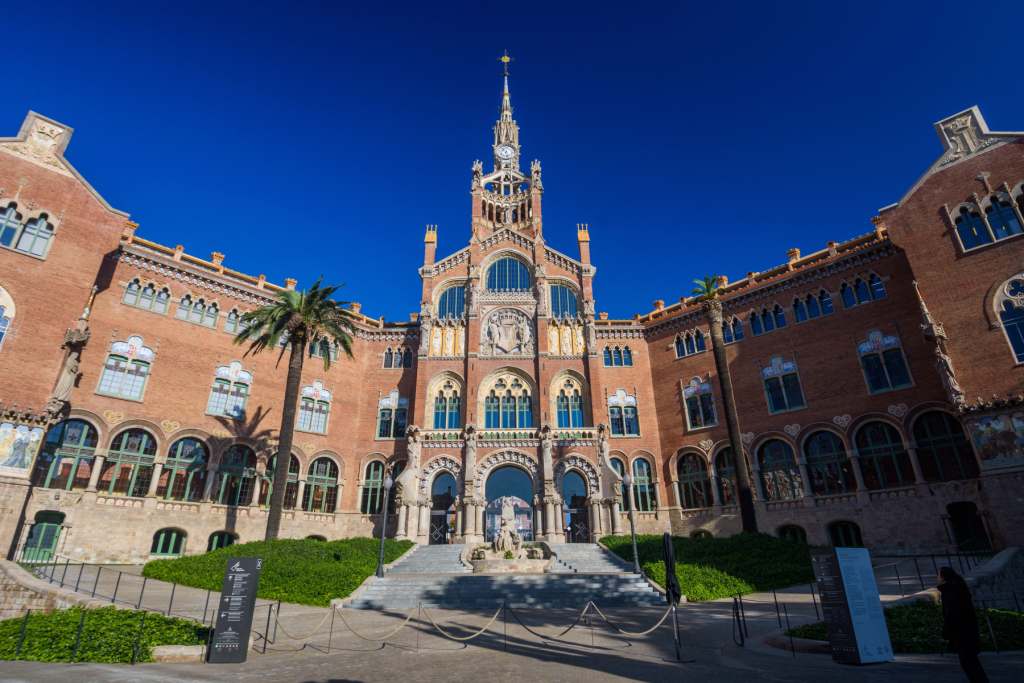Mike East explores two examples of the wonderful architecture in Barcelona Spain giving Gaudi a miss.
Let me start with a disclaimer: go and see all the marvellous works of Gaudi that you can. For the Sagrada Familia, buy your tickets in advance, so you are assured of the experience. See Park Güell and the Casa Batilo and Casa Mila (though again, check the ticket situation a few weeks before you go). Take your time and appreciate the genius.
I have nothing but the highest praise for Gaudi’s craft, which has been so well covered elsewhere. But, this piece is about two other places that are well worth your time to explore. For those mapping out their sightseeing, you may find this 4-Day Itinerary in Barcelona especially useful.
Barcelona Architecture I : Sant Pau Hospital
Let’s start with the Sant Pau Hospital, which has eight of the twelve pavilions restored. Work is still needed on some of the far buildings, but there is much to see, making it a wonderful experience of Art Nouveau architecture. Designed by the Catalan architect Lluis Domenech I Montaner (one of the city’s prominent streets celebrates him), and built between 1902 and 1930, it is a UNESCO World Heritage building.
In its time, the hospital was highly innovative. The separate buildings were connected by underground passages and the patient wards gave out to beautiful gardens, created to aid the patients’ recovery. Part of one of the original wards has been recreated in the Saint Rafael Pavilion, allowing us to appreciate the philosophy behind the design. Other areas display the medical equipment of the early twentieth century.
One of the tunnels has a display of photography from different periods of the hospital’s history. The Administrative Pavilion contains some of the most intricate decorations and from the upper floor, above the entrance you can see the boulevard that runs straight down to the Sagrada Familia. Sculptures and mosaics on the building’s exterior record key moments in the history of the hospital.
It is claimed to be the world´s largest Art Nouveaux complex. You may go round free style or take the audio tour, which takes about 90 minutes.
Barcelona Architecture II : Castell de Montjuic
Moving on to a piece of military Barcelona architecture that comes with 360-degree views of the city is the Castell de Montjuic. It is a pleasant walk, though do not leave it too late in the heat of summer. Part of the way up is the Hotel Miramar, on the Mediterranean side. A little further are some large swimming pools, facing towards the Sagrada Familia, that are open to the public and a wonderful place to relax. From the same point a cable car can take you up to the castle at the summit, or you can continue on foot.
A fort was built here in 1640 by rebellious Catalans to defend the city. and it successfully held off a royalist attack. The military architecture that we see today was the work of the engineer Juan Martín Cermeño in the style of Vauban. From 1779 it was completely rebuilt to take over 100 cannons, only to be surrendered to Napoleon in 1808. At different periods in its history, it also served as a prison.
There is a dry moat and a footbridge that lead to the visitor´s centre, where audioguides are available. At weekends and holidays, there are guided tours in English at 1pm.
Perhaps the greatest experience of a visit is the sweeping views available from the parade ground terrace, though there is also a footpath around the outside of the castle and various routes down.
A huge yellow and red flag fluttering in the wind proclaims the castle as part of Catalonia.
Things to Do in Barcelona
For more information on things to do in Barcelona go to Turisme de Barcelona. You can also see our article on the rooftops of Barcelona.
Architecture in Barcelona
If you wish to discover more about Barcelona architecture, including Gaudi’s you can check out this Lonely Planet article.

